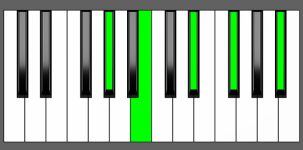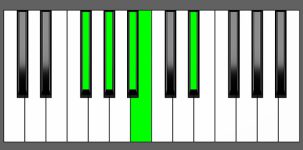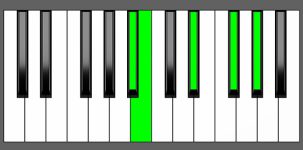Piano Diagram of Abm9 in Root Position

The Abm9 chord consists of six notes which are the root note (Ab), the minor third (Cb), the perfect fifth (Eb), the minor seventh (Gb), and the major ninth (Bb). This chord is often used as an alternative or as a transition for minor 7th chords.
Structure of Abm9
Notes |
|---|
| Ab, Cb, Eb, Gb, Bb |
Intervals |
|---|
| R, m3, 5, m7, 9 |
Playing Extended Chords on Piano
Extended chords are commonly used in piano playing, but they can be tricky to play in their entirety due to the large number of notes involved. To make these chords more manageable, pianists often omit certain notes, such as the root or the 5th. Another technique is to split the chord between both hands, playing either full or partial chords in each hand.
For instance, in this scenario, you may opt to play a simplified version of Abm9 by omitting the 5th note. This way, you will only need to play the root note Ab (which can be played using your left hand), the minor 3rd Cb (B), the minor 7th Gb, and the 9th note Bb with your right hand.
However, even when notes are omitted or split between hands, extended chords can still create complex and dense harmonies. When these chords are inverted, the resulting clusters of notes can be particularly challenging to voice effectively.
Abm9 Chord Inversions
The Abm9 chord has a total of 4 inversions:
| Root Position: | Ab | Cb | Eb | Gb | Bb |
| 1st Inversion: | Cb | Eb | Gb | Ab | Bb |
| 2nd Inversion: | Eb | Gb | Ab | Bb | Cb |
| 3rd Inversion: | Gb | Ab | Bb | Cb | Eb |
| 4th Inversion | Bb | Cb | Eb | Gb | Ab |
Piano Keyboard Diagrams

Chord Inversion on Piano
Having a solid understanding of chord inversions is a crucial aspect of music theory because it helps to clarify how chords are built and utilized in progressions. However, when playing chord inversions on a piano, it’s important to keep in mind that the diagrams that demonstrate the order of notes may not always be practical to play.
To achieve the correct chord voicings on a piano, you need to spread the notes of the chord across different octaves and positions on the keyboard. This often means that the basic shape of the chord’s inversions illustrated in diagrams may not be the most convenient or comfortable way to play the chord.
Even though chord inversion diagrams can help understand the structure and sequence of notes in a chord, it’s advisable to experiment with various voicings and fingerings to find the most efficient and comfortable way to play the chord while still maintaining its intended harmonic function and sound.
Music Theory and Harmony of Abm9
The Abm9 chord is essentially an Abm7 with a 9th added. While it can be substituted for the Abm7 chord in any position, it is commonly used in conjunction with it. Nonetheless, it’s worth noting that certain positions may not be as effective when substituting Abm9 for Abm7, and in some positions, the Abm9 is a non-diatonic chord.
Building the Abm9 Chord: Different Approaches
Starting from the Ab Major Scale
To build a minor 9th chord, you would use the root note, the third, the fifth, the seventh, and the ninth from a minor scale, however, for educational purposes, it may be clearer to demonstrate its construction using a major scale, as it better illustrates the relationship between intervals and their qualities.


To create an Abm9 chord, apply the formula R, m3, 5, m7, 9 in the following manner:
- Begin with the Root note, Ab.
- Select the 3rd interval, C then subtract a half-step to get the minor 3rd Cb (B).
- Add the 5th interval, which is Eb.
- Add the minor 7th interval, which is the 7th (G) less a half-step, Gb.
- Finally, include the major 9th interval, which is the second note at a higher octave, Bb.
By following this simple formula, you can create a minor 9th chord from any major scale.
by Combining Intervals
One method to create a minor 9th chord is by combining specific intervals – a minor 3rd, a major 3rd, a minor 3rd, and a major 3rd. This is the formula:
m3 + 3 + m3 + 3 = minor 9th Chords
When analyzing the Abm9 chord, we can observe that:
- the interval between Ab and Cb is a minor 3rd,
- between Cb and Eb is a major 3rd,
- between Eb and Gb is a minor 3rd,
- and between Gb and Bb is a major 3rd.
by Combining Chords
Another way to create minor 9th chords is to combine a minor triad with the minor chord based on its 5th note.
For example, to get an Abm9 chord, you can mix an Ab minor triad with an Eb minor chord. These two chords share the note Eb, and when played together, they form an Abm9 chord.
Ab minor + Eb minor = Abm9
How to Use Abm9 in a Chord Progression
The Ab minor 9th chord is a variation of the Ab minor 7th chord that includes an additional 9th note as part of its diatonic extension.
In this post, we will be focusing on the common applications of the Abm9 chord. The tables below display the major and minor keys and include the Ab minor 7th chord, which can be replaced or accompanied by an Ab minor 9th chord.
Non-diatonic positions in Db minor and E Major
It’s important to note that the major ninth interval Bb present in an Ab min9, clashes with the A note found in both the Db minor and Fb (E) major scales. They are very close, only a half step apart. Due to this dissonance, it’s generally recommended to avoid using a minor 9th chord in this specific situation. However, instead of completely avoiding it, you can try experimenting with an Abm9 chord in these positions to see how dissonant it sounds. Ultimately, the decision of whether or not to use it depends on your personal preference.
Abm9 in Theoretical Keys
In most cases, the Abm9 chord is found in theoretical keys rather than commonly used keys. To simplify and make it more practical, it is often preferred to refer to the enharmonic equivalent keys of these theoretical keys.
on Natural minor Scales
| Minor Scales | i | ii | III | iv | v | VI | VII |
|---|---|---|---|---|---|---|---|
| Ab | Ab min7 ⇒ Abm9 | Bbm7b5 | Cb Maj7 | Db min7 | Eb min7 | Fb Maj7 | Gb7 |
| Eb | Eb min7 | Fm7b5 | Gb Maj7 | Ab min7 ⇒ Abm9 | Bb min7 | Cb Maj7 | Db7 |
| Db = C# | C# min7 | D#m7b5 | E Maj7 | F# min7 | G#m7 ⇒ G#m9 = Abm9 | A Maj7 | B7 |
- Tonic chord in Ab minor
- Subdominant chord in Eb minor
- Non-diatonic Dominant chord in C# minor as G#min9
on Major Scales
| Major Scales | I | ii | iii | IV | V | vi | vii |
|---|---|---|---|---|---|---|---|
| Gb | Gb Maj7 | Ab min7 ⇒ Abm9 | Bb min7 | Cb Maj7 | Db7 | Eb min7 | Fm7b5 |
| Fb = E | E Maj7 | F# min7 | G#m7 ⇒ G#m9 = Abm9 | A Maj7 | B7 | C# min7 | D#m7b5 |
| Cb = B | B Maj7 | C# mi7 | D# min7 | E Maj7 | F#7 | G#m7 ⇒ G#m9 = Abm9 | A#m7b5 |
- Supertonic chord in Gb Major
- Non-diatonic Mediant chord in E Major as G#min9
- Submediant chord in B Major as G#min9
Abm9 Function in Major and Minor Keys
Understanding Scale Degrees
Understanding scale degrees is essential for comprehending the relationship between the notes within chords and how they function. The diatonic major scale consists of seven degrees, each with a distinct role in shaping the overall harmony of the chords.
- The first degree of the scale is the Tonic, serving as the foundation for the chord progression. It establishes a stable tonal center, providing an anchor for the rest of the chords in the progression.
- The second degree is called the Supertonic, often used to create a sense of motion within the chord progression. It acts as a transitional chord between the Tonic and other chords in the progression.
- The third degree of the scale is the Mediant, sitting halfway between the Tonic and Dominant chords. It helps determine whether the chord progression is major or minor.
- The fourth degree is the Subdominant, complementing the Dominant and adding tension and resolution to the chord progression.
- The fifth degree is the Dominant, creating tension and anticipation within the chord progression, typically resolved by returning to the Tonic.
- The sixth degree is the Submediant, often employed as a transitional chord between the Dominant and Tonic, adding a sense of stability and restfulness to the chord progression.
- The seventh degree is the Leading tone, located one half-step below the Tonic. It creates a strong sense of tension and a desire to resolve to the Tonic, frequently used to create a sense of resolution and finality in the chord progression.
Abm9 as Tonic Chord in Ab minor
The Ab minor 9th chord is an interesting choice for the tonic chord in the Ab minor key because of the added tension and dissonance of the 9th interval (Bb). This creates an unstable and uncertain sound that can be useful for creating tension. However, it’s important to note that this dissonance can make the chord difficult to use in some musical situations.
The Abm9 can be used to modulate between keys or to add harmonic color and contrast to a composition.
| i | ii | III | iv | v | VI | VII |
| Ab min7 | Bbm7b5 | Cb Maj7 | Db min7 | Eb min7 | Fb Maj7 | Gb7 |
Abm9 Chord Progressions as i degree
The following chord progressions are examples of how the Ab minor 9th chord can serve as the tonic chord (i degree).
i VI VII III
| i | VI | VII | III |
| Ab mi9 | Fb Maj7 | Gb7 | Cb Maj7 |
i iv VI VII
| i | iv | VI | VII |
| Abm9 | Abm7 | Db min7 | Fb Maj7 | Gb7 |
I prefer resolving the Ab min9 chord to a more stable Ab chord (Ab minor or Ab minor 7th) within the same measure, but I encourage you to explore different options and experiment with other chord progressions to see what sounds best to you.
Circle Progression
| i | iv | VII | III | VI | ii | V7 | i |
| Abm9 | Abm7 | Dbm7 | Gb7 | Cb Maj7 | Fb Maj7 | Bbm7b5 | Eb7 | Ab min7 |
Abm9 as Subdominant Chord in Eb minor
The Ab minor 9th can also be played as a variation of the subdominant chord in the key of Eb minor.
| i | ii | III | iv | v | VI | VII |
| Eb min7 | Fm7b5 | Gb Maj7 | Ab min7 | Bb min7 | Cb Maj7 | Db7 |
Abm9 Chord Progressions as iv degree
The following chord progressions feature an Abm9 chord as the subdominant (iv degree):
iv III VI VII
| iv | III | VI | VII |
| Ab min9 | Gb Maj7 | Cb Maj7 | Db7 |
i iv VI v
| i | iv | VI | v |
| Eb min7 | Ab min9 | Cb Maj7 | Bb min7 |
Circle Progression
| i | iv | VII | III | VI | ii | V7 | i |
| Eb min7 | Abm9 | Abm7 | Db7 | Gb Maj7 | Cb Maj7 | Fm7b5 | Bb7 | Eb min7 |
Abm9 as Dominant Chord in Db minor (Non-Diatonic)
Abm9 as Supertonic Chord in Gb Major
Besides its use in minor keys, the Abm9 chord can also be played in major keys. In the key of Gb major, for instance, the Abm9 chord can be used as the supertonic chord, located on the second degree of the scale.
| I | ii | iii | IV | V | vi | vii |
| Gb Maj7 | Ab min7 | Bb min7 | Cb Maj7 | Db7 | Eb min7 | Fm7b5 |
Abm9 Chord Progressions as ii degree
Try playing the following chord progressions to better understand how the Abm9 chord functions as the supertonic (ii) chord in the key of Gb major.
ii V I
| ii | V | I |
| Abm9 | Abm7 | Db7 | Gb Maj7 |
Circle Progression
| I | IV | vii | iii | vi | ii | V | I |
| Gb Maj7 | Cb Maj7 | Fm7b5 | Bb min7 | Eb min7 | Abm9 | Abm7 | Db7 | Gb Maj7 |
Abm9 as Mediant Chord in Fb Major (Non-Diatonic)
Abm9 as Submediant Chord in Cb Major
Alternative Abm9 Nomenclature
- Ab m9
- Ab -7/9
- Ab min9
- Ab m7/9
- Ab minor9
- Ab min7/9
- Ab -7(add9)
- Ab minor7/9
- Ab m7(add9)
- Ab minor 9th
- Ab min7(add9)
- Ab min7(add9)
- Ab Dominant minor 9th
- Ab Dominant minor ninth



